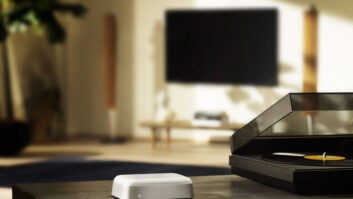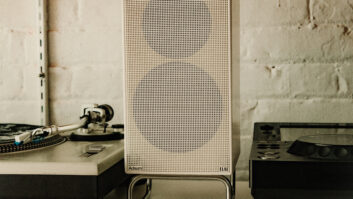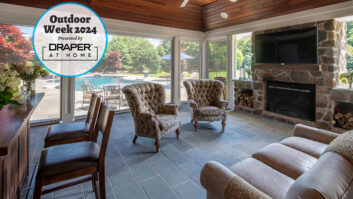A good multi-purpose room should have the same design goals as a good single-function room. In either case, were seeking the best audio and video performance we can get. While it is easier to optimize this performance in a room in which the sole function is to deliver great AV entertainment, multipurpose rooms create additional challenges. There are creative ways, however, to transform a room into one for multiple functions.
Far and away, [a large number] of what people think of as home theaters are actually multipurpose rooms, noted John Dahl, senior fellow and director of education for THX Ltd. Percentage-wise, dedicated rooms represent a small portion of the market.
In a room that must serve multiple functions, compromise is almost inevitable. For that reason its important to set client expectations. While it is easy to fall into the thinking that the entire project will be one big compromise, Anthony Grimani, president of audio and acoustical consultancy Performance Media Industries Ltd., encourages a more positive attitude: first, consider how the project could be perfect, then look for the chinks in that perfect armor. The exercise, Grimani says, is about reducing the size of the imperfections, to create as close to perfect a room as possible.
Control the Light
In home theaters, the most important consideration is optimization of picture quality. Dahl recommends watching 1080p, high-quality images at a viewing angle of 40 degrees, which is achieved by multiplying the seat-to-screen distance by 0.75. If the prime-viewing seat is 80 inches from the screen, a 60-inch-wide (not diagonal) screen would cover a 40-degree angle of view.
Light coming through windows will wash out a video display or screen image. Curtains and shades can help cut some of this external brightness as well as add acoustical benefits if chosen wisely. There are some very good acoustically conducive shade systems, said Richard Rives Bird, president of audio firm Rives Audio Inc. We use Hunter Douglas honeycomb cellular shades quite a lot. They have a good absorption coefficientone thats more consistent than draperies.
The right display can also be beneficial when it comes to light control. Direct-view displays, such as plasmas, LCDs, or CRTs, are less affected by extraneous light than a (front) projection system, with rear-projection systems falling somewhere in between these two extremes.
Even with direct-view screens, it is still necessary to ensure that light from a window or lamp wont create an irritating reflection on the screen. Again, curtains, drapes or shades can provide a solution, and if they are motorized, they can be tied into lighting scenes.
Front projections create a different kind of problem: light from the projected image can reflect off of a white ceiling or walls and bounce back to fall on darker portions of the image, draining black from once pitch-black images. This represents a loss of contrast, or visual dynamic range. The solution: go for darker hues on the walls and ceiling. Many manufacturers of projection screens offer models that have high directivity screens, which are usually gray-toned, reject off-axis light, and return more of the light from the projector back toward the viewer. In cases where dark room surfaces are not an option, a high-directivity screen should be considered.
While direct-view technologies have clear advantages in the multi-purpose room setting, Grimani believes there is a place for projection systems, too. Doing a front-projection system in a multi-purpose room is work, he admitted, but the benefits are: better picture quality, potentially less cost, and the fact that it can disappear [if retractable].
Acoustically transparent projection screens allow sound from the center-channel speaker (and in some cases, all three front speakers) to come through the screen. This is a huge advantage as no other system arrangement permits the critical center-channel speaker to be so exactly placed.
Take a Seat
How can we create a multipurpose room with inviting seating and a place for conversation, while also offering good sight lines and sound during movies or while listening to music? A monitor placed in front of a three-seat couch flanked by two loveseats, as Bird pointed out, can be an uncomfortable seating position for those on the loveseat who will have to turn at an angle to watch the screen. To fine tune this seating placement, Grimani suggests replacing the flanking loveseats with swivel chairsoverstuffed, those with swivel bases, or even swivel recliners. Bird recommends Ekornes furniture, which he has used frequently to good effect.
Another approach is to put sliders on the loveseatsnot very high-tech, but certainly practical and effective. Well often put a little bar counter behind that three-seat couch and then put mid-height bar stools behind that, for overflow seating, Bird said. It works out extremely well. There are no tiers; everybody has a good visual sight line. In fact were seeing more of that than tiered seating. Even in a dedicated room, many clients are going away from tiered seating.
Keep it Quiet
When an installer has done a great job in a home theater, Dahl noted, two things immediately become apparent: excellent bass, and the quietness of the room, which allows for rich sound details even when the volume is low. When we consider that many multipurpose rooms are doorless, with archways as the access point, and in many cases, are connected to hallways, entrance-ways, or other rooms in the home, it is difficult to conceive of sound isolation.
The best and first course of action would be to replace archways with well-gasketed, solid-core doors. If conventional swing-open doors arent possible, rattle-free doors that slide out of pockets within the archway might be a good alternative.
In a situation where a clients great room is connected to a kitchen via a large archway, Bird and his team replaced the archway with high-density fiberglass, fiberglass bass traps, and fiberglass-hiding columns.
When there are open archways, sound originating in the media room will spill through to other rooms, reverberate, and then reflect back into the media room. To avoid such long-delay reflections, the adjoining rooms and hallways will have to be treated to absorb as much of the spill-over sound as possible. If youre trying to get sound isolation between the media room and other rooms in the house, and you cant put doors on the media room, then think about which rooms youre trying to protect, said Bonnie Schnitta, president of SoundSense and acoustical materials supplier NoiseOut Essentials. You might, for example, want to keep sound from the media room out of a bedroom down the hall. In that case, Schnitta said, put a heavy, solid-core door with good acoustical seals on that bedroom, and lots of acoustically absorbent materials on the hallways and stairways leading to it.
Grimani suggests using laterally closing or vertical roll-up drapes when a door on the media room is out of the question. Weve done a number of convertible rooms, Grimani noted, where a soffit is built over the archway, and a motorized drape comes downa drape thats made out of the right sandwich of materials to give sufficient sound transmission loss to be effective.
A key component in this sandwich of materials is a one-sixteenth-inch thick mass-loaded vinyl that is layered internally with a fabric matrix to give it tear-resistance. Flexible, the vinyl can be covered with fabric and sandwiched with acoustically absorbent materials such as flannel or products made specifically for the purpose. When the drape is down it reduces sound reflection from adjoining rooms, while keeping the listening room spill-over to a minimum.
Windows, of course, are notoriously poor in sound isolation. In new construction, spec the best sound-isolating windows possible, especially if the home is in a high-traffic or noisy area. The Quiet Solution and others offer windows specially engineered for high isolation. Even on retrofits, replacing existing windows with high-isolation versions is a good decision.
To improve conventional windows, Grimani recommends a window with a high thermal insulation rating, as these will have better seals, cutting down on one of the sound migration paths. Second, get a double-pane window with dissimilar layers of glass, so that one pane is thicker than the other. This is because every material has a natural resonance frequency, determined by its mass and stiffness. The windowpane will vibrate readily at its resonant frequency, and will act like an open window to sounds at this frequency. Staggering the two windowpanes resonance frequencies effectively closes that window.
Treat the Room Right
No matter what the room ismultipurpose or notthe reverberation time has to be correct, Schnitta said. This requires particular attention given todays architectural and dcor trends, which lean toward spareness, lots of glass, plenty of hard surfaces, and few drapes.
NoiseOut Essentials is a business based specifically on solving this problem and has a wide variety of pillows, curtains, rugs, and furniture, that offers varying degrees of acoustical absorbency or dispersion. Uniquely, NoiseOut takes a hands-on approach to acoustic room correction. The company has a toll-free number for customers to speak with an engineer, who armed with a rooms specification, can produce a requirements sheet showing how much acoustical absorbencyusing proprietary methodology and NoiseOut Essentials Units (NEU)is needed.
Grimani also has a line of high-style acoustical-control products offered under the Salon Acoustics label. Essentially, everything including graphics, artistic prints, and photographs can be printed at high resolution on acoustically transparent cloth. Streched around a frame, the cloth is then backed with several inches of acoustically absorptive material. The result is an acoustical absorber as art (www.msr-inc.com/salon_art.php).
It can all be done, and it can all be done really well, said Grimani on designing multipurpose rooms. It just takes a little bit more creativity than the traditional dedicated room would take. If youre willing to take the time to put the creativity into it, youll wind up with good results.
A former loudspeaker designer, Alan R. Frank ([email protected]) is a networking consultant and freelance writer covering the fields of communications, networking, and digital entertainment.






